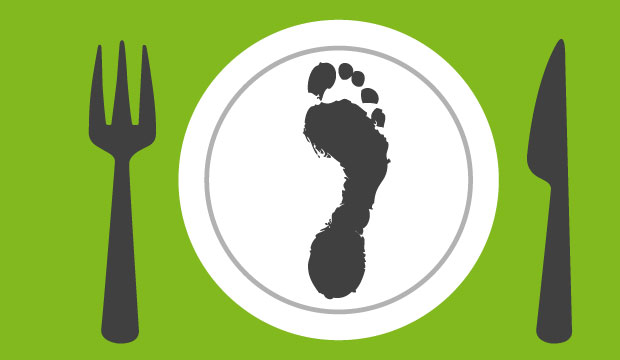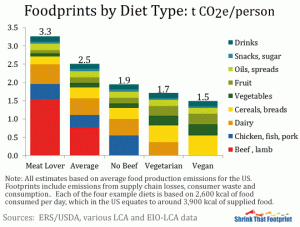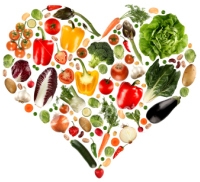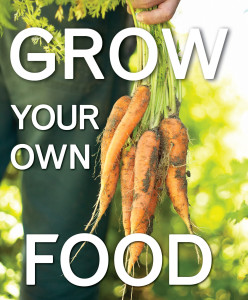How Much Co2 Is Produced for 1 Pound of Beef

Your carbon foodprint
Food's carbon footprint, or foodprint, is the greenhouse gas emissions produced by growing, rearing, farming, processing, transporting, storing, cooking and disposing of the food you eat.
In the US, each household produces 48 tons of greenhouse gases. Transport, housing and food have the three largest carbon footprints. Food produces about 8 tons of emissions per household, or about 17% of the total. Worldwide, new reports suggest that livestock agriculture produces around a half of all man-made emissions.
Changing the foods that you eat can have a big impact on your carbon footprint. And reduce pollution, preserve the environment and slow global warming. Many of these changes will also save you money, improve your health and even keep you fit! Have a browse of How You Can Fight Climate Change for more ideas on taking action to save our beautiful planet.
Carbon Footprint Ranking of Food
The following table shows the greenhouse gas emissions produced by one kilo of each food. It includes all the emissions produced on the farm, in the factory, on the road, in the shop and in your home. It also shows how many miles you need to drive to produce that many greenhouse gases. For example, you need to drive 63 miles to produce the same emissions as eating one kilogram of beef.
Meat, cheese and eggs have the highest carbon footprint. Fruit, vegetables, beans and nuts have much lower carbon footprints. If you move towards a mainly vegetarian diet, you can have a large impact on your personal carbon footprint.
| Rank | Food | CO2 Kilos Equivalent | Car Miles Equivalent |
| 1 | Lamb | 39.2 | 91 |
| 2 | Beef | 27.0 | 63 |
| 3 | Cheese | 13.5 | 31 |
| 4 | Pork | 12.1 | 28 |
| 5 | Turkey | 10.9 | 25 |
| 6 | Chicken | 6.9 | 16 |
| 7 | Tuna | 6.1 | 14 |
| 8 | Eggs | 4.8 | 11 |
| 9 | Potatoes | 2.9 | 7 |
| 10 | Rice | 2.7 | 6 |
| 11 | Nuts | 2.3 | 5 |
| 12 | Beans/tofu | 2.0 | 4.5 |
| 13 | Vegetables | 2.0 | 4.5 |
| 14 | Milk | 1.9 | 4 |
| 15 | Fruit | 1.1 | 2.5 |
| 16 | Lentils | 0.9 | 2 |
Figures from the Environmental Working Group's Meat Eater's Guide and the EPA's Guide to Passenger Vehicle Emissions.
Top Tips for Reducing your Carbon Footprint
1. Food's Carbon Footprint: Eat vegetarian

Livestock farming produces from 20% to 50% of all man-made greenhouse gas emissions.
Shrink That Footprint's chart shows that a meat lover has the highest carbon footprint at 3.3 tons of greenhouse gas emissions. A vegan diet has the lowest carbon footprint at just 1.5 tons CO2e (Carbon Dioxide Equivalent). You can reduce your foodprint by a quarter just by cutting down on red meats such as beef and lamb.
The carbon footprint of a vegetarian diet is about half that of a meat-lover's diet.
It's good for the animals too! Most animals are raised in factory farms where they live in horrific conditions. The factory workers also suffer from poor wages and dangerous working practices. Factory farms are heavy polluters of the air and ground. The meat they produce is also polluted with superbugs. Over 3.5 million people get sick from eating 'dirty' meat every year in the US.
It's good for you too! Vegetarians live longer than meat-eaters. Vegetarians are slimmer than meat-eaters. Vegetarians have a lower risk of getting heart disease, high blood pressure, diabetes and cancer.
Browse Healthy Eating for more tips on a healthy, vegetarian diet.
- use proteins such as beans, lentils, tofu, tempeh and quorn to replace meat, cheese and eggs
- make sure you are getting enough iron and zinc by including lots of wholegrains, beans and a variety of vegetables
- invest in some vegetarian or vegan cookery books and have fun experimenting
- don't rely on vegetarian processed foods.
Green Fact: 70% of the deforestation of the Amazon is to provide land for cattle ranches.
2. Food's Carbon Footprint: Bring back home-cooking
Take control of the food you eat and base your meals on natural foods such as vegetables, fruits, whole-grains, beans and lentils with a little meat and fish:
- discover the simple pleasures of preparing and eating your own meals
- check out Vegetarian Recipes for lots of tasty ideas
- improve the health of you and your family – see more at Vegetarian Nutrition
- plan your meals ahead to reduce wastage
- save your leftovers and create a new meal with them
- if you can, make your own compost with uncooked vegetable scraps.
Check out Why Food Waste is a Good Thing! for more tips on how to reduce food wastage.
Green Fact: British and American households throw out a THIRD of the food that they buy!
3. Food's Carbon Footprint: Cooking smartly
Did you know that a gas oven only uses 6% of its energy to cook? And an electric oven is not much better at 12%. If you use the oven on a warm day, you will also heat up the room and need to turn on a fan or air-conditioning. In fact, the most efficient cooking method is simmering on the stove-top.
- eat more raw foods that do not need cooking
- use the stove-top whenever possible
- next best is the microwave as it uses 50% less energy than an oven
- use the oven sparingly and smartly…reduce preheating, cook multiple foods, turn off early
- use electric kettles to boil water for cooking or drinking.
 4. Food's Carbon Footprint: Eat Organic
4. Food's Carbon Footprint: Eat Organic
Organic farming methods for both crops and animals have a much lower impact on the environment than conventional methods. Organic-certified farms must use natural methods for soil fertilisation, weed prevention and pest control. Antibiotics and growth hormones cannot be used to raise food animals, and there are standards of care which prevent cruelty to livestock. Genetically-modified and irradiated foods cannot be labelled organic and its better to avoid these processes which are not proven to be safe for us or the food chain.
Organic food is better for you too! Crops are grown in fertile soils that are full of nutrients – and these end up in your food and then in you. Livestock are able to roam the fields and eat their natural food – grass – rather than being force-fed corn. And this leads to a much less fatty meat that keeps your heart healthier.
Find out which fruits and vegetables are the worst and least contaminated with pesticides at Eat Organic, Drink Clean.
Green Fact: poor soil management costs the US $10 billion every year in lowered yields and lost nutrients.
5. Food's Carbon Footprint: Save water
Water is a precious resource that is becoming scarce in many countries such as Egypt, Mexico, Pakistan and Australia. And even if you do not live in one of these arid countries, you may be wearing or using goods and consuming foods produced in those places, thus contributing to their water debt. One of the major impacts we can have personally is by moving towards a vegetarian diet, which requires about half the water to produce than a meat-based diet. It also makes sense to reduce your personal water consumption by practicing water conservation in your daily life:
- eat a mainly vegetarian diet
- only use the dishwasher when full and select the program with low water usage
- if you wash-up by hand, start with a half-empty bowl and rinse the dishes back into your washing-up water rather than down the plughole
- use filtered tap water for drinking rather than energy and water-intensive bottled water
- take a shower rather than a bath and shower less often in less time!
- turn off the taps when brushing your teeth or washing or shaving
- clean your clothes less often and only wash full loads
- use 'grey' water to water your garden and house-plants.
Green Fact: the average Australian uses around 30,000 gallons of water per year around the home for drinking, washing, cooking, laundry etc but it takes around 400,000 gallons of water to produce the crops that feed and clothe them!
6. Food's Carbon Footprint: Shop wisely
Think before you buy! Do you actually need this? Can you find a better, greener alternative?
- use a shopping list to avoid those impulse purchases
- avoid products that use lots of packaging
- buy in bulk to save money and reduce packaging
- check the label – a long list of ingredients generally means a heavily processed item with a high carbon footprint
- frozen food has the highest carbon footprint, followed by canned, plastic, glass, then cardboard
- and please don't buy bottled water.
Green Fact: around 5,000 million pounds weight of plastic water bottles were produced in 2005 and only 20% were recycled. That's a lot of waste in our landfills, on our streets and in our oceans.

Take the bus 🙂
7. Food's Carbon Footprint: Shop local
Think about where you do your shopping. Do you drive to the local shop when you need something – why not walk? Does your supermarket support green initiativesand offer local, organic foods? Is there a nearby farmer's market or co-op you can use? And think about where food comes from – if it is from the other side of the world, it will have a high transportation footprint.
A weekly food shop is a habit many of us follow…but is it an efficient use of time and resources? The average household throws away a third of the food that they buy as it is so easy to over-shop in those tempting supermarkets. After all, they are designed to sell us as much as possible, whether we need it or not. What about shopping in bulk every other week for non-perishable goods, and using your local shops for fresh foods?
Green fact – around 11% of the greenhouse emissions involved in food production are linked to food transportation.
8. Food's Carbon Footprint: Reuse and recycle
Think creatively about how you can reuse and recycle. Glass jars and plastic containers make great storage options. Take your own shopping bags and say no to plastic bags. Take reusable produce bags for your fruit and vegetables – if you use the ethylene-absorbing bags it prolongs shelf-life too. And when you can't reuse, make sure you recycle whatever you can.
 9. Food's Carbon Footprint: Grow your own food
9. Food's Carbon Footprint: Grow your own food
A great way to save money, get fit and reduce your carbon footprint is to grow your own fruit and vegetables. If you have a garden or backyard, then it is a fun way to make sure your family has access to affordable, healthy, pesticide-free food. And even if you live in an apartment, what about using your balcony or even the communal outside areas? Failing that, there is a growing movement (ha!) in Australia and The States to set up community gardens.
Food's Carbon Footprint – how to reduce your carbon footprint by eating healthily.
Source: https://www.greeneatz.com/foods-carbon-footprint.html
Post a Comment for "How Much Co2 Is Produced for 1 Pound of Beef"